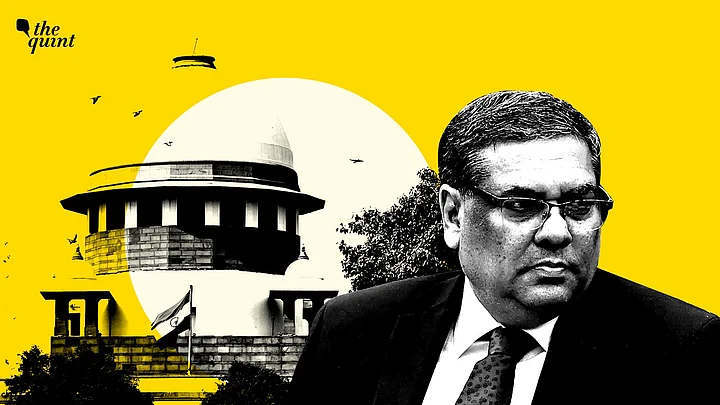The change from one Chief Justice of India to another is always a moment to reflect on the tenure of the outgoing justice and the expectations and challenges awaiting the new incumbent.
Justice Sanjiv Khanna, who has handed the gavel to Justice BR Gavai, remained in office for six months, but instead of becoming a blip in the Supreme Court’s recent history, his tenure marked a period of stability after a tumultuous time. Among the most contentious cases he inherited were those related to the Places of Worship Act.
From the day he took office in November 2024, Justice Khanna emphasised the role of the judiciary as an institution over that of any individual—even the Chief Justice.
This stood in marked contrast to some of his predecessors who seemed to privilege the individual over the institution. Justice Khanna’s tenure served as a course-correction; his quiet firmness reassuring many that justice backsliding could be halted, even reversed.
Justice Khanna repeatedly underscored the importance of free legal aid, first as the patron-in-chief of the National Legal Services Authority in April 2023, when he spoke about the extremely low per capita spending on legal aid in India, and then again just a few days before his retirement.
He said,
“According to the recent India Justice Report 2025, the ratio of legal aid clinics to the villages stands at 1:163, the ratio of para-legal volunteers for beneficiary is three per one lakh, and the national per capita expenditure on legal aid is Rs 6.46."
Institution Over the Individual
By referring to this massive resource crunch, Justice Khanna was highlighting the oft-overlooked reality: the strength of the justice system cannot rely on the altruism of a handful of pro-bono lawyers or upright police officers.
During Justice Khanna’s two-decade-long career as a judge—first at the Delhi High Court and since 2019 at the Supreme Court—he has articulated his core belief several times: access to justice cannot be guaranteed without equal access for all.
"Justice in one sense can be described as existence of rules that provide right to a fair and a just decision, rules that provide equal and fair opportunity of winning against the most powerful and against the state itself. Now, in this sense if one looks at it, justice and access to Justice are intertwined and inseparable."Justice Khanna speaking in Varanasi in January 2023
Again, he seemed to give a clear message to his peers, juniors, and other stakeholders, especially the executive: privilege the institution, not the individual.
In his last speech as Chief Justice, he reiterated: “Often a person's true character is revealed in not what they say about themselves but in what they choose to leave unsaid.”
Justice Khanna hardly spoke outside the courtroom but his actions have ensured that his tenure will be remembered for doing more and saying less.
Chip of the Old Block
Justice Khanna’s role as Chief Justice of the Supreme Court cannot be analysed through any simplistic scale. While he didn’t give a verdict on the contentious Waqf Act, his judicial pronouncements persuaded the government to promise abatement on the most controversial—and what some have called communal—aspects.
Similarly, in the several cases related to religious disputes over sites such as Sambhal, he has put all such matters into abeyance untill the validity of the Places of Worship Act 1991 is decided. The Act holds that the nature of any place of worship cannot be changed if it predates 15 August 1947.
Demonstrating a deep understanding of doing the best in far-from-ideal conditions, Justice Khanna took the unprecedented decision to make public the video footage of burnt cash discovered at the official residence of Delhi High Court’s Justice Yashwant Varma.
On 8 May, days before his retirement, he directed the committee probing the allegations to proceed with investigations. While this is not what proponents of transparency and equality would condone, given the holy cow status of our judiciary, Justice Khanna has raised the bar when it comes to probity of judges.
Shortly after demitting office, Justice Khanna announced that he would not accept any government assignments post-retirement. This public commitment to staying away from office and the concomitant comforts is itself like a ray of light in a chamber that has remained dark for too long.
He may be a third-generation legal luminary, but as we have seen through the publication of recent data on the assets of judges and kinship in the higher judiciary, the temptation to hold a public office is rarely resisted.
A Measured Legacy, Not Without Gaps
It is impossible for a judge to please all parties, even at the best of times. Justice Khanna too leaves behind a few unresolved and unsavoury issues, such as the case of Justice Shekhar Yadav of the Allahabad High Court, who remains in office despite making communally charged statements at an imprudent platform.
Similarly, the judgment of the Supreme Court upholding the Calcutta High Court order quashing recruitment of over 25,000 teachers has attracted criticism from political quarters.
But Justice Khanna perhaps has done what few expected: demonstrated to his peers, and his colleagues at the Bar and the Bench across the nation, that it is possible to stand by one's convictions—quietly, but firmly.
As he said in his farewell speech, “I have attended so many farewells… the sentiment commonly expressed on such occasions is that of mixed feeling… let me confess I have no mixed feelings, I am simply happy”.
(Valay Singh is the lead at India Justice Report. This is an opinion piece. The views expressed above are the author’s own. The Quint neither endorses nor is responsible for them.)
